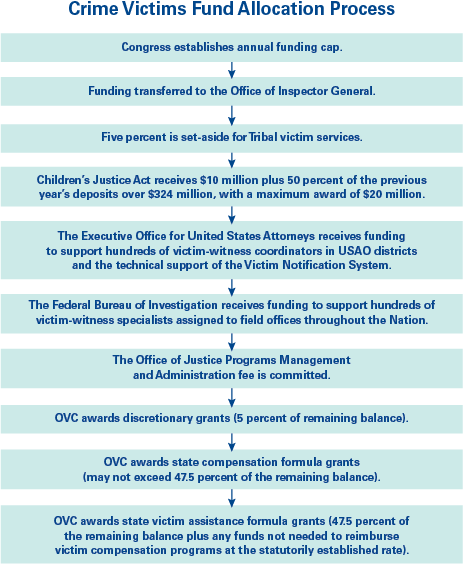Overview
See the YouTube Terms of Service and Google Privacy Policy
The Crime Victims Fund (the Fund) was established by the Victims of Crime Act (VOCA) of 1984. The Fund is financed by fines and penalties from convictions in federal cases, not from tax dollars.
As of September 2025, the Fund balance is over $3.5 billion and includes deposits (also known as receipts) from federal criminal fines, forfeited bail bonds, penalties, and special assessments collected by U.S. Attorneys' Offices, federal courts, and the Federal Bureau of Prisons.
On July 22, 2021, President Biden signed the VOCA Fix to Sustain the Crime Victims Fund Act of 2021 in a historic effort to stabilize the Fund. The VOCA Fix requires any funds that would otherwise be deposited in the general fund of the U.S. Treasury collected pursuant to federal deferred prosecution and non-prosecution agreements to go into the Crime Victims Fund.
Federal revenues deposited into the Fund also come from gifts, donations, and bequests by private parties, as provided by an amendment to VOCA through the USA PATRIOT Act in 2001 that went into effect in 2002. Since 2002, hundreds of thousands of dollars have been deposited into the Fund through this provision.
The Fund's Cap
When the Fund was authorized in 1984, a cap was placed on how much could be deposited into it for the first 8 years. During this time, the annual cap varied from $100 million to $150 million. The lifting of the cap in 1993 allowed for the deposit of all criminal fines, special assessments, and forfeited bail bonds to support crime victim program activities.
For the first 15 years of the Fund's existence, the total deposits for each fiscal year were distributed the following year to support services to crime victims.
Starting in Fiscal Year (FY) 2000, in response to large fluctuations in deposits, Congress placed a cap on funds available for distribution (also known as obligations). These annual caps were intended to maintain the Fund as a stable source of support for future victim services. From FY 2000 to 2018, the amount of the annual cap varied from $500 million to more than $4 billion.
The cap was set at $2.015 billion in FY 2021 and $2.6 billion and $1.9 billion in FY 2022 and FY 2023, respectively.
The cap has a direct impact on the allocation process. For example, trend data indicates state victim assistance formula grant allocations fluctuate similarly to the obligation cap. Despite fluctuating allocations, the number of subgrants awarded and subgrantee organizations funded remained relatively constant as did the number of victims served. In FY 2022, subgrantees served 9.8 million victims, including new and returning individuals.
Allocation Process
Federal, state, and Tribal victim assistance programs receive formula grants, discretionary grants, and set-asides according to a carefully established annual allocation process outlined below.


